Earthquake Experts Condemn 'Appalling' Italy Manslaughter Verdict

Seismologists and other earth scientists are condemning a manslaughter verdict for six Italian scientists and one government official accused of being too reassuring about the risk of an earthquake prior to a deadly temblor in 2009.
The researchers, all far from Italy, used words like "unfair," "incredible" and "ridiculous" in discussing the verdict, which comes after a yearlong trial in L'Aquila, Italy.
"I think it's very unfair and very stupid," said Seth Stein, an earth scientist at Northwestern University in Illinois. "It reflects a kind of fundamental misunderstanding of what science can and can't do."
After a series of small temblors in early 2009, the six seismologists and the government official held a public meeting in which they said it was "unlikely" that the shaking foreshadowed a larger quake. Days later, on April 6, 2009, a 6.3-magnitude quake struck, crumbling L'Aquila's medieval buildings and killing 309 people. [Photos: Destruction in L'Aquila]
Natural disasters on trial
Prosecutors charged that the researchers were too blasé about the risk and asked for four years' jail time for manslaughter for each. Today (Oct. 22), Judge Marco Billi took about four hours to find the defendants guilty, sentencing them to six years apiece. An appeal is likely.
However, earthquake experts said the scientists had been unfairly scapegoated for failing to predict the unpredictable.
Get the world’s most fascinating discoveries delivered straight to your inbox.
"It's too easy to predict an earthquake after the fact and say everyone should have cleared out, but beforehand people, for good reason, thought the risk was low," said John Vidale, a University of Washington seismologist. In fact, Vidale said, the scientists' statements that the quake was unlikely were true.
"There was a very small chance of that earthquake," Vidale told LiveScience. "It didn't make sense for people to evacuate."
Other researchers objected to blaming scientists for civil evacuation decisions.
"The idea is ridiculous, to hold scientists responsible for public policy," said Chris Goldfinger, a professor of geology and geophysics at Oregon State University. "First, scientists have almost zero ability to predict earthquakes, and second, have no direct responsibility for public policy. Something has gone seriously wrong in the Italian legal system."
Many large earthquakes are preceded by small foreshocks, but there's no way to know when a small quake foreshadows a larger one, seismologists say. One 1998 study of Italian earthquakes found that only 2 percent of small clusters of quakes predicted a large shock.
Evacuation is typically not the best response to these small swarms, according to a 2010 article published in the journal Geophysical Research Letters. That study found the likelihood of death for citizens in L'Aquila's least-safe buildings was still only about one in 100,000 — a risk that's better ameliorated by retrofitting dangerous buildings than evacuating entire towns for indeterminate lengths of time on the slight chance of a quake, the researchers concluded. (No charges have been brought in L'Aquila regarding building codes or standards.)
Fallout from the verdict
Italy's system for communicating earthquake risk before the trial was imperfect, seismologists contacted by LiveScience agreed. Risk communication tended toward the informal, and defendant Bernardo De Bernardinis, then-deputy chief of Italy’s Civil Protection Department, responded to a reporter's query regarding whether town residents should relax about the earthquakes with a glass of wine by suggesting a vintage.
Nevertheless, researchers said the assessment of risk as low was an accurate assessment, and feared that the criminal verdict might put a damper on future communication improvements. The verdict is also likely to make it harder for Italy to attract top geoscientists, Vidale said.
"We know that the system in Italy for communicating risk before the L'Aquila earthquake was flawed, but this verdict will cast a pall over any attempt to set up a better one. I'm afraid that many scientists are learning to keep their mouths shut," Thomas Jordan, an earth scientist at the University of Southern California and the director of the Southern California Earthquake Center, told LiveScience. "This won't help those of us who are trying to improve how risks from natural hazards are communicated between scientists and the public." [Natural Disasters: Top U.S. Threats]
Jordan was a member of a commission convened by the Italian government after the L'Aquila earthquake to improve quake communication. The recommendations, submitted before the L'Aquila trial began, include open sources of scientific information for the public, rigorous earthquake forecasting data, and communication methods approved as effective by social science research.
The key to communicating risk about natural disasters, researchers agreed, is to let the public know what scientists don't know.
"The real problem is helping people understand how risk works," Erik Klemetti, a geoscientist at Denison University in Ohio, told LiveScience. "You can't expect that scientists can come in and tell people 'an earthquake will happen here on October 28, 2013.' Instead, they must understand that there is an increased probability of earthquakes or eruptions in certain areas — and that they must take responsibility for understanding the risks of where they live."
Andrea Thomspon, Douglas Main and Becky Oskin contributed reporting.
Follow Stephanie Pappas on Twitter @sipappas or LiveScience @livescience. We're also on Facebook & Google+.

Stephanie Pappas is a contributing writer for Live Science, covering topics ranging from geoscience to archaeology to the human brain and behavior. She was previously a senior writer for Live Science but is now a freelancer based in Denver, Colorado, and regularly contributes to Scientific American and The Monitor, the monthly magazine of the American Psychological Association. Stephanie received a bachelor's degree in psychology from the University of South Carolina and a graduate certificate in science communication from the University of California, Santa Cruz.


